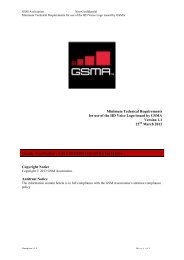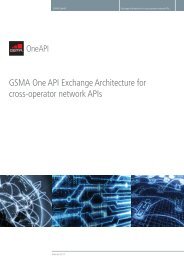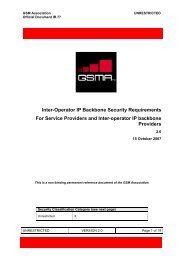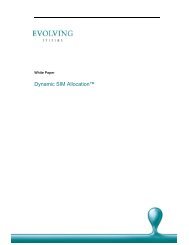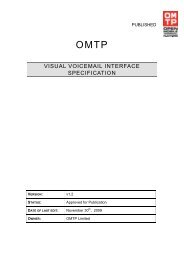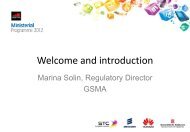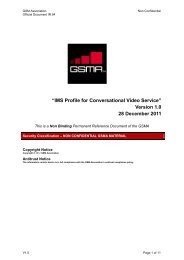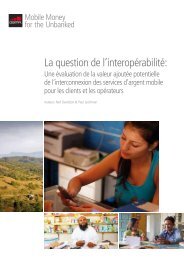Guidelines for IP Addressing and AS Numbering for GRX/IPX - GSMA
Guidelines for IP Addressing and AS Numbering for GRX/IPX - GSMA
Guidelines for IP Addressing and AS Numbering for GRX/IPX - GSMA
You also want an ePaper? Increase the reach of your titles
YUMPU automatically turns print PDFs into web optimized ePapers that Google loves.
GSM Association Non-Confidential<br />
Official Document IR.40<br />
<strong>Guidelines</strong> <strong>for</strong> <strong>IP</strong> <strong>Addressing</strong> <strong>and</strong> <strong>AS</strong> <strong>Numbering</strong> <strong>for</strong><br />
<strong>GRX</strong>/<strong>IP</strong>X Network Infrastructure <strong>and</strong> User Equipment<br />
V6.0 Page 1 of 22<br />
V6.0<br />
30 March 2011<br />
This is a Binding Permanent Reference Document of the GSM Association.<br />
Security Classification – NON-CONFIDENTIAL <strong>GSMA</strong> Material<br />
Copyright Notice<br />
Copyright © 2011 GSM Association<br />
Antitrust Notice<br />
The in<strong>for</strong>mation contain herein is in full compliance with the GSM Association’s antitrust compliance policy.
GSM Association Non-Confidential<br />
Official Document IR.40<br />
Table of Contents<br />
1 Introduction ...................................................................................................... 3<br />
1.1 Overview ..................................................................................................... 3<br />
1.2 Scope .......................................................................................................... 3<br />
1.3 Definition of Acronyms <strong>and</strong> Abbreviations ................................................... 4<br />
1.4 Definition of Terms ...................................................................................... 5<br />
1.5 Document Cross-References ...................................................................... 5<br />
2 General <strong>Guidelines</strong> .......................................................................................... 6<br />
3 <strong>IP</strong> <strong>Addressing</strong> Policy <strong>Guidelines</strong> <strong>for</strong> <strong>GRX</strong>/<strong>IP</strong>X Network Infrastructure......... 6<br />
3.1 General requirements .................................................................................. 6<br />
3.2 Policy guideline details ................................................................................ 7<br />
3.2.1 <strong>Addressing</strong> <strong>for</strong> <strong>IP</strong>X/<strong>GRX</strong> network infrastructure ........................................... 7<br />
3.2.2 Utilising existing assigned public address space ......................................... 7<br />
3.2.3 Requesting new Public address space ........................................................ 7<br />
3.2.4 Notification of infrastructure address assignment to <strong>GSMA</strong> ......................... 8<br />
3.2.5 Notification of infrastructure address assignment to <strong>GRX</strong>/<strong>IP</strong>X Provider(s) ... 8<br />
3.3 Guidance notes ........................................................................................... 8<br />
3.3.1 LIR registration ............................................................................................ 8<br />
3.3.2 Requesting Public <strong>IP</strong> address space ........................................................... 8<br />
4 Autonomous System Number <strong>Guidelines</strong> <strong>for</strong> Network Infrastructure ......... 8<br />
4.1 General requirements .................................................................................. 8<br />
4.2 <strong>AS</strong>N range ................................................................................................... 9<br />
4.3 Policy guideline details ................................................................................ 9<br />
5 <strong>IP</strong> <strong>Addressing</strong> Policy <strong>Guidelines</strong> <strong>for</strong> User Equipment ................................. 10<br />
5.1 General ..................................................................................................... 10<br />
5.1.1 Version of <strong>IP</strong> addresses............................................................................. 10<br />
5.1.2 <strong>IP</strong>v4 Public <strong>and</strong> Private addressing ........................................................... 10<br />
5.1.3 Network Address Translation (NAT) .......................................................... 11<br />
5.2 Service Provider assignment to User Equipment ....................................... 12<br />
5.2.1 General ..................................................................................................... 12<br />
5.2.2 Con<strong>for</strong>mance to RIR policies ..................................................................... 13<br />
5.2.3 UE Public Address Space request <strong>and</strong> approval guideline details ............. 13<br />
6 Annex A: Internet Registry System .............................................................. 15<br />
6.1 Overview ................................................................................................... 15<br />
6.2 ICANN ....................................................................................................... 15<br />
6.3 Address Supporting Organisation (<strong>AS</strong>O) ................................................... 16<br />
6.4 Regional Internet Registry (RIR) ................................................................ 16<br />
6.5 National Internet Registries ....................................................................... 17<br />
6.6 Delegated Registries ................................................................................. 17<br />
6.7 Local Internet Registries ............................................................................ 17<br />
6.8 End Users ................................................................................................. 17<br />
7 Annex B: RIR Public <strong>IP</strong> address request web links ..................................... 19<br />
Document Management .......................................................................................... 20<br />
Other In<strong>for</strong>mation ................................................................................................... 22<br />
V6.0 Page 2 of 22
GSM Association Non-Confidential<br />
Official Document IR.40<br />
1 Introduction<br />
1.1 Overview<br />
The <strong>GRX</strong> Network was first established in 2000 <strong>for</strong> the purpose of GPRS roaming <strong>and</strong> only<br />
GSM operators were allowed to connect to it. Since then other services have been added<br />
such as UMTS roaming <strong>and</strong> MMS interworking.<br />
With the development of IMS <strong>and</strong> S<strong>IP</strong>-related services, the <strong>GSMA</strong> has recognised the need<br />
to involve organisations outside the GSM/UMTS community <strong>and</strong> has facilitated the <strong>GRX</strong><br />
network evolving into the <strong>IP</strong>X concept. Organisations outside the <strong>GSMA</strong> membership will be<br />
allowed to connect <strong>for</strong> the purpose of IMS/S<strong>IP</strong> interworking <strong>and</strong> other similar services. This<br />
document has been updated to reflect the fact that non-GSM organisations may connect to<br />
the <strong>IP</strong>X. Terminology has also been changed:<br />
� An organisation connecting to the <strong>IP</strong>X network is known as a “Service Provider”.<br />
� The term “User Equipment” is now used in place of “Mobile Terminal” <strong>and</strong> "User<br />
Terminal" where appropriate.<br />
All organisations connected to the <strong>IP</strong>X network, irrespective of whether they are GSM<br />
operators or not, will need to adhere to a common set of <strong>IP</strong> addressing rules <strong>and</strong> related<br />
guidelines that are described in this document.<br />
The <strong>GSMA</strong> worked closely with the all the RIR communities (R<strong>IP</strong>E NCC, ARIN <strong>and</strong> APNIC)<br />
to develop <strong>and</strong> produce the early versions of this document. This was essential to ensure<br />
that the proposed guidelines to the Service Providers associated with requesting <strong>and</strong><br />
implementing Public addresses are aligned with the existing policies <strong>and</strong> procedures of the<br />
RIR community.<br />
Annex A provides an overview on the Internet Registry System <strong>and</strong> its hierarchical<br />
architecture, ranging from the overall co-ordinating body (ICANN) to the end user.<br />
Annex B identifies some useful web links <strong>for</strong> each RIR associated with their services <strong>and</strong><br />
Public <strong>IP</strong> address request policies <strong>and</strong> procedures.<br />
This document is produced <strong>and</strong> maintained by the <strong>GSMA</strong>. However, unlike other documents<br />
produced by this organisation, its intended readership extends beyond its members to also<br />
include the RIR community. Hence, the style <strong>and</strong> language used in this document has<br />
attempted to accommodate this wider audience wherever possible.<br />
The respective party can submit any changes/comments to this document as follows:-<br />
� <strong>GSMA</strong> members: mailto:iregpacket@infocentre.gsm.org (using existing change<br />
request procedures)<br />
� RIRs: via the authors of this document or directly to the <strong>GSMA</strong> via the GSM World<br />
web site mailto:info@gsmworld.com.<br />
It should be noted that this document been assigned a ”Non Confidential” classification so<br />
that it can be distributed within the Public Domain. This document will be made available on<br />
the Public GSM World web site http://www.gsmworld.com/about/index.html.<br />
1.2 Scope<br />
This document provides addressing-related guidelines to organisations wishing to<br />
inter-connect to each other using a private <strong>IP</strong> Backbone network including the <strong>GRX</strong> network<br />
<strong>and</strong> its successor, the <strong>IP</strong>X. It covers the following areas related to addressing:<br />
1. <strong>IP</strong> addressing <strong>for</strong> Service Provider <strong>and</strong> <strong>GRX</strong>/<strong>IP</strong>X Provider network<br />
infrastructure<br />
2. Autonomous System (<strong>AS</strong>) <strong>Numbering</strong> of the <strong>IP</strong> network associated with a<br />
Service Provider’s network infrastructure<br />
V6.0 Page 3 of 22
GSM Association Non-Confidential<br />
Official Document IR.40<br />
3. <strong>IP</strong> addressing <strong>for</strong> User Equipment (UEs)<br />
The above is described in a service-agnostic way, but references to other relevant <strong>GSMA</strong><br />
PRDs where necessary.<br />
This document also describes how Service Providers can request <strong>IP</strong> addresses <strong>and</strong><br />
Autonomous System Numbers (<strong>AS</strong>Ns) <strong>for</strong> use with their networks using procedures that are<br />
aligned with the Internet Registry System <strong>and</strong> the GSM Association (<strong>GSMA</strong>).<br />
In association with item 3 above, some guidelines are also provided <strong>for</strong> consideration by the<br />
Regional Internet Registry (RIR) communities to assist with their existing procedures <strong>for</strong><br />
processing Public <strong>IP</strong>v4 address space requests received from Service Providers.<br />
Administration <strong>and</strong> Governance procedures <strong>for</strong> the <strong>IP</strong>X network are being established.<br />
Currently, these new procedures are out of scope <strong>and</strong> this document refers throughout to<br />
the <strong>GSMA</strong>.<br />
1.3 Definition of Acronyms <strong>and</strong> Abbreviations<br />
Acronym /<br />
Abbreviation<br />
Description<br />
AfriNIC African Network In<strong>for</strong>mation Centre<br />
APN Access Point Name<br />
APNIC Asia Pacific Network In<strong>for</strong>mation Centre<br />
ARIN American Registry <strong>for</strong> Internet Numbers<br />
<strong>AS</strong> Autonomous System<br />
<strong>AS</strong>N Autonomous System Number<br />
<strong>AS</strong>O Address Supporting Organisation<br />
<strong>AS</strong>P Application Service Provider<br />
BGP Border Gateway Protocol<br />
DNS Domain Name System<br />
DR Delegated Registry<br />
FNO Fixed Network Operator<br />
GGSN Gateway GPRS Support Node<br />
GPRS General Packet Radio Service<br />
<strong>GRX</strong> GPRS Roaming eXchange<br />
HPLMN Home PLMN<br />
IANA Internet Assigned Number Authority<br />
ICANN Internet Corporation <strong>for</strong> Assigned Names <strong>and</strong> Numbers<br />
IETF Internet Engineering Task Force<br />
<strong>IP</strong> Internet Protocol<br />
IR Internet Registry<br />
ISP Internet Service Provider<br />
LACNIC Latin American Continent Network In<strong>for</strong>mation Centre<br />
LAN Local Area Network<br />
LIR Local Internet Registry<br />
MoU Memor<strong>and</strong>um of Underst<strong>and</strong>ing<br />
MT Mobile Terminal<br />
NAT Network Address Translation<br />
NIR National Internet Registry<br />
PC Personal Computer<br />
PDN Packet Data Network<br />
PDP Packet Data Protocol<br />
PLMN Public L<strong>and</strong> Mobile Network<br />
PRD Permanent Reference Document<br />
R<strong>IP</strong>E NCC Réseaux <strong>IP</strong> Européens Network Coordination Centre<br />
RFC Request <strong>for</strong> Comments<br />
RIR Regional Internet Registry<br />
SGSN Serving GPRS Support Node<br />
V6.0 Page 4 of 22
GSM Association Non-Confidential<br />
Official Document IR.40<br />
Acronym /<br />
Abbreviation<br />
Description<br />
SSL Secure Socket Layer (protocol)<br />
UT User Terminal<br />
VLSM Variable Length Subnet Mask<br />
VPLMN Visited PLMN<br />
WAP Wireless Access Protocol<br />
WTLS Wireless Transport Layer Security<br />
1.4 Definition of Terms<br />
Term Description<br />
Public Address Registered <strong>IP</strong>v4 address [12].<br />
Private Address Unregistered <strong>IP</strong>v4 address [5].<br />
Service<br />
Provider<br />
A business entity entering into a contractual relationship with one or more <strong>IP</strong>X<br />
provider(s). Thus, "Service Provider" includes MNOs, FNOs (<strong>for</strong> example, fixed<br />
broadb<strong>and</strong> operators <strong>and</strong> NGNs), ISPs, <strong>AS</strong>Ps <strong>and</strong> so on.<br />
PLMN Operator A mobile network operator offering GPRS / UMTS services. This term is used<br />
where the document applies specifically to this type of operator <strong>and</strong> not to the<br />
more general "Service Provider".<br />
<strong>IP</strong>X Provider A business entity (such as an <strong>IP</strong> Carrier) offering <strong>IP</strong> interconnect capability <strong>for</strong><br />
one or many <strong>IP</strong>X Services compliant with the <strong>IP</strong>X requirements.<br />
1.5 Document Cross-References<br />
Ref<br />
Document<br />
Number<br />
Title<br />
1 N/A Ripe-185: European Internet Registry Policies <strong>and</strong> Procedures; R<strong>IP</strong>E<br />
Local Internet Registry Working Group<br />
http://www.ripe.net/docs/ripe-185.html<br />
2 IETF RFC 1930 "<strong>Guidelines</strong> <strong>for</strong> creation, selection <strong>and</strong> registration of an Autonomous<br />
System"<br />
3 <strong>GSMA</strong> PRD IR.21 "<strong>GSMA</strong> roaming database, structure <strong>and</strong> updating procedures"<br />
4 <strong>GSMA</strong> PRD IR.34 "Inter-Service Provider <strong>IP</strong> Backbone <strong>Guidelines</strong>"<br />
5 IETF RFC 1918 Address allocation <strong>for</strong> Private Internets<br />
6 3GPP TS 23.060 General Packet Radio Service (GPRS); Service description; Stage 2<br />
7 N/A OMA WAP related specifications:<br />
Wireless Application Protocol Push Architectural Overview<br />
Wireless Application Protocol Push Proxy Gateway Service<br />
Specification<br />
http://www.openmobilealliance.org/Technical/wapindex.aspx<br />
http://www.openmobilealliance.org/tech/affiliates/LicenseAgreement.a<br />
sp?DocName=/wap/wap-250-pusharchoverview-20010703-a.pdf<br />
http://www.openmobilealliance.org/tech/affiliates/LicenseAgreement.a<br />
sp?DocName=/wap/wap-249-ppgservice-20010713-a.pdf<br />
8 <strong>GSMA</strong> PRD IR.33 GPRS Roaming <strong>Guidelines</strong><br />
9 IETF RFC 3027 Protocol complications with the <strong>IP</strong> Network Address Translator<br />
10 IETF RFC 2993 Architectural implications of NAT<br />
11 3GPP TS 29.061 Interworking between PLMN supporting GPRS PDN<br />
12 IETF RFC 791 Internet Protocol<br />
13 <strong>GSMA</strong> PRD IR.88 LTE Roaming <strong>Guidelines</strong><br />
V6.0 Page 5 of 22
GSM Association Non-Confidential<br />
Official Document IR.40<br />
2 General <strong>Guidelines</strong><br />
The guidelines presented in this document are based upon the following two fundamental<br />
requirements:<br />
1. Existing request policies <strong>and</strong> procedures operated by the RIRs must be adhered to<br />
when Service Providers request Public <strong>IP</strong> address space <strong>and</strong> Public <strong>AS</strong>N.<br />
a. Each service provider must individually submit a request <strong>for</strong> Public <strong>IP</strong><br />
address space <strong>and</strong> Public <strong>AS</strong>N in accordance with these policies <strong>and</strong><br />
procedures.<br />
b. Private addresses must be used wherever possible <strong>for</strong> UT addressing where<br />
<strong>IP</strong>v4 addressing is needed.<br />
c. Public addresses are only used <strong>for</strong> UT addressing <strong>for</strong> services where it can<br />
be demonstrated that the use of Private addresses is not feasible or<br />
practical.<br />
d. Public addresses will not be issued <strong>for</strong> purposes that this document has<br />
shown can be supported using Private addresses, unless the requestor can<br />
demonstrate otherwise.<br />
2. Public address space (particularly that of <strong>IP</strong>v4) must be conservatively <strong>and</strong> efficiently<br />
used.<br />
a. Private addressing must be used wherever possible <strong>for</strong> <strong>IP</strong>v4. Public<br />
addressing in <strong>IP</strong>v4 must only be considered where it is not possible or<br />
practical to support Private <strong>IP</strong>v4 addressing.<br />
b. Dynamic <strong>IP</strong> addressing should be deployed wherever possible to conserve<br />
both the Public (<strong>and</strong> Private <strong>IP</strong>v4) address space available.<br />
c. Wherever possible, utilise any previously assigned spare Public address<br />
space be<strong>for</strong>e requesting new Public addresses.<br />
The following has been agreed between the <strong>GSMA</strong> <strong>and</strong> the RIR communities in relation to<br />
the guidelines presented in this document above:<br />
1. <strong>IP</strong> addressing guidelines <strong>for</strong> network infrastructure <strong>and</strong> User Equipment:<br />
a. Public addresses are requested from RIRs <strong>for</strong> this purpose using the existing<br />
RIR request policies <strong>and</strong> procedures.<br />
2. <strong>AS</strong>N guidelines:<br />
a. Public (registered) <strong>AS</strong>Ns are requested <strong>for</strong> use in the network infrastructure<br />
using their existing request policies <strong>and</strong> procedures.<br />
b. Private (unregistered) <strong>AS</strong> Numbers can be requested from the <strong>GSMA</strong> via the<br />
following email address: "as_number@gsm.org".<br />
3 <strong>IP</strong> <strong>Addressing</strong> Policy <strong>Guidelines</strong> <strong>for</strong> <strong>GRX</strong>/<strong>IP</strong>X Network<br />
Infrastructure<br />
3.1 General requirements<br />
This section of the document provides guidelines to Service Providers to request <strong>and</strong> use<br />
Public <strong>IP</strong>v4 <strong>and</strong> <strong>IP</strong>v6 addresses <strong>for</strong> their network infrastructure. <strong>Guidelines</strong> covering the<br />
issue <strong>and</strong> use of <strong>IP</strong>v6 addressing is considered work in progress in this version of the<br />
present document.<br />
V6.0 Page 6 of 22
GSM Association Non-Confidential<br />
Official Document IR.40<br />
It is essential that all Service Providers adopt these guidelines <strong>and</strong> adhere to the<br />
procedures <strong>and</strong> processes of the Internet Registry System in order <strong>for</strong> interworking on the<br />
<strong>IP</strong>X network to operate successfully.<br />
These guidelines do not guarantee that a Service Provider will be assigned public <strong>IP</strong><br />
address space. Address space assignment will be assessed on an individual request basis<br />
as per the existing request policies <strong>and</strong> procedures of the Internet Registry System.<br />
Service Providers will have one or more <strong>IP</strong> networks to host their services offered on the<br />
<strong>IP</strong>X network, whether GPRS/UMTS roaming, IMS/S<strong>IP</strong>, MMS etc.<br />
<strong>GSMA</strong> PRD IR.34 [4] provides further technical details on the <strong>IP</strong>X network.<br />
Each <strong>IP</strong>-addressable network element involved in the above services on the <strong>IP</strong>X network<br />
must be uniquely addressed.<br />
When the <strong>GRX</strong> network was first proposed, investigations conducted by the <strong>GSMA</strong> with the<br />
Internet community identified that Public addresses would provide the most practical<br />
solution to meet its addressing requirements. This addressing solution has been carried<br />
<strong>for</strong>ward as the <strong>GRX</strong> has evolved into the <strong>IP</strong>X.<br />
3.2 Policy guideline details<br />
3.2.1 <strong>Addressing</strong> <strong>for</strong> <strong>IP</strong>X/<strong>GRX</strong> network infrastructure<br />
Public <strong>IP</strong> address space must be used on all network elements involved in the <strong>GRX</strong>/<strong>IP</strong>X<br />
network by Service Providers <strong>and</strong> <strong>IP</strong>X Providers.<br />
Any Public <strong>IP</strong> addresses used on the <strong>IP</strong>X network must not duplicate Public <strong>IP</strong> addresses<br />
used on the public Internet.<br />
Private <strong>IP</strong>v4 address space (as defined in IETF RFC 1918 [5]), rather than Public <strong>IP</strong>v4<br />
address space, can <strong>and</strong> should be used wherever possible within Service Providers' internal<br />
network <strong>and</strong> <strong>IP</strong>X Providers' internal network. This is recommended in order to reduce the<br />
amount of Public <strong>IP</strong>v4 address space required from RIRs. Use of <strong>IP</strong>v6 address space within<br />
the Service Provider's internal network is <strong>for</strong> further study.<br />
3.2.2 Utilising existing assigned public address space<br />
Service Providers may already have Public address space which has previously been<br />
assigned to them. To help conserve the Public address space, wherever possible, service<br />
providers should utilise any such existing address space <strong>for</strong> addressing their network<br />
infrastructure be<strong>for</strong>e requesting new Public addresses <strong>for</strong> this purpose.<br />
Note that if the assignment of Public address space is changed <strong>for</strong> another purpose than it<br />
was originally requested <strong>for</strong>, the details of this change of address usage should be notified<br />
by the Service Provider to the organisation, which made the original address allocation. This<br />
could be the LIR, NIR, DR, RIR, or an ISP. In case of any doubt, the RIR should be<br />
in<strong>for</strong>med.<br />
3.2.3 Requesting new Public address space<br />
New Public address space assignment must be requested by Service Providers <strong>and</strong> <strong>IP</strong>X<br />
Providers from the appropriate LIR/NIR/DR using existing procedures supported by its<br />
respective serving RIR.<br />
This document can be used as part of the request submitted by the Service Provider as a<br />
source of reference to help explain the requirement <strong>for</strong> Public address space.<br />
The LIR/NIR/DR selected should be one that is served by one of the three RIRs that is<br />
responsible <strong>for</strong> serving the country of the requesting Service Provider.<br />
The <strong>IP</strong> address space request policies <strong>and</strong> procedures can be obtained from the respective<br />
RIR's home web sites as defined in Annex A.<br />
V6.0 Page 7 of 22
GSM Association Non-Confidential<br />
Official Document IR.40<br />
3.2.4 Notification of infrastructure address assignment to <strong>GSMA</strong><br />
It is the Service Provider's responsibility to notify their interconnect/roaming partner Service<br />
Provider(s) of the Public <strong>IP</strong> address range(s) assigned to their network infrastructure <strong>for</strong> all<br />
the <strong>IP</strong> based services they operate on the <strong>GRX</strong>/<strong>IP</strong>X network. This must be done so that the<br />
other Service Provider can configure the appropriate security mechanisms at the edge of<br />
their network.<br />
For Service Providers who are members of the <strong>GSMA</strong>, <strong>GSMA</strong> PRD IR.21 [3] should be<br />
used <strong>for</strong> notifying the <strong>GSMA</strong> <strong>and</strong> other Service Providers of the Public address range(s)<br />
being used by that Service Provider. It is the responsibility the Service Providers to maintain<br />
<strong>and</strong> keep this in<strong>for</strong>mation up to date. Other mechanisms may be used, but these are outside<br />
the scope of the present document.<br />
3.2.5 Notification of infrastructure address assignment to <strong>GRX</strong>/<strong>IP</strong>X Provider(s)<br />
It is the Service Provider's responsibility to notify their <strong>GRX</strong>/<strong>IP</strong>X Provider(s) of the Public <strong>IP</strong><br />
address range(s) assigned to their network infrastructure <strong>for</strong> all the <strong>IP</strong> based services they<br />
operate on the <strong>GRX</strong>/<strong>IP</strong>X network. This must be done so that the <strong>GRX</strong>/<strong>IP</strong>X Provider can<br />
configure the appropriate security mechanisms within their network.<br />
Note that a Service Provider must not include any <strong>IP</strong> address ranges used <strong>for</strong> User<br />
Terminals in the range of infrastructure <strong>IP</strong> addresses notified to the <strong>IP</strong>X Provider(s). This<br />
point is explained further in section Error! Reference source not found..<br />
<strong>GRX</strong>/<strong>IP</strong>X Providers must ensure that they do not include routing in<strong>for</strong>mation <strong>for</strong> User<br />
Terminal <strong>IP</strong> address ranges on their networks. This provides an extra layer of security<br />
against attacks initiated from User Terminals.<br />
3.3 Guidance notes<br />
3.3.1 LIR registration<br />
<strong>GRX</strong>/<strong>IP</strong>X network connectivity is normally provided by international data carriers. These<br />
organisations are usually already established as LIRs. Hence, they will already have the<br />
necessary administration in place to process requests <strong>for</strong> Public <strong>IP</strong> addresses from the<br />
Service Providers.<br />
A Service Provider may belong to an organisation that already has an ISP as part of its<br />
constituent, <strong>and</strong> this ISP is likely to be registered as an LIR (or member) of the respective<br />
RIR. In this case, the ISP may be in a position to provide the necessary administration to<br />
process requests <strong>for</strong> Public <strong>IP</strong> addresses from its associated network operator. This may be<br />
the preferred option <strong>for</strong> larger Service Providers. Smaller Service Providers may elect to<br />
request their address space requirements from their <strong>GRX</strong>/<strong>IP</strong>X Provider, or from the ISP<br />
associated with another Service Provider that is registered as an LIR.<br />
3.3.2 Requesting Public <strong>IP</strong> address space<br />
Annex B provides some useful in<strong>for</strong>mation on requesting Public <strong>IP</strong> address space <strong>for</strong> the<br />
different RIRs.<br />
4 Autonomous System Number <strong>Guidelines</strong> <strong>for</strong> Network<br />
Infrastructure<br />
4.1 General requirements<br />
This section of the document provides guidelines to Service Providers to request <strong>and</strong> assign<br />
an Autonomous System Number (<strong>AS</strong>N) to their network infrastructure.<br />
V6.0 Page 8 of 22
GSM Association Non-Confidential<br />
Official Document IR.40<br />
The total <strong>IP</strong> network of a Service Provider connected to the <strong>GRX</strong>/<strong>IP</strong>X Network is considered<br />
as an Autonomous System (<strong>AS</strong>).<br />
Each <strong>AS</strong> may have an associated <strong>AS</strong> Number (<strong>AS</strong>N) to uniquely identify it. This identifier is<br />
used in the routing process to interconnect the <strong>IP</strong> networks of other service providers across<br />
the <strong>IP</strong>X network.<br />
A service provider can elect to use either a Public or a Private <strong>AS</strong>N, the only proviso being<br />
that a Private <strong>AS</strong>N must never be advertised on the Internet.<br />
More in<strong>for</strong>mation on <strong>AS</strong> numbers, mainly oriented towards their use on the Internet is<br />
available in IETF RFC 1930 [2].<br />
4.2 <strong>AS</strong>N range<br />
The <strong>AS</strong>N is defined as a 16-bit integer, hence limited to 65535 unique values.<br />
The Internet Registry System has divided the <strong>AS</strong>N space <strong>for</strong> Public <strong>and</strong> Private uses as<br />
follows:<br />
� Public <strong>AS</strong>N range: 0 through to 64511<br />
� Private <strong>AS</strong> number range: 64512 through to 65535 (i.e. 1024 values)<br />
4.3 Policy guideline details<br />
The following sections describe the policy guidelines <strong>and</strong> provide guidance notes <strong>for</strong><br />
Service Providers to request <strong>and</strong> implement a Public or Private <strong>AS</strong>N <strong>for</strong> their network<br />
infrastructure.<br />
1. The need <strong>for</strong> use of an <strong>AS</strong>N depends on a Service Provider’s connectivity to the<br />
<strong>GRX</strong>/<strong>IP</strong>X network.<br />
� If a Service Provider exchanges routing in<strong>for</strong>mation with one or more <strong>GRX</strong>/<strong>IP</strong>X<br />
Providers, <strong>for</strong> example using BGP, use of an <strong>AS</strong>N is m<strong>and</strong>atory.<br />
� Otherwise, use of an <strong>AS</strong>N is optional although there is minimal benefit from using<br />
an <strong>AS</strong>N in this case.<br />
2. A Service Provider can elect to use either a Public <strong>AS</strong>N or a Private <strong>AS</strong>N (as defined<br />
in section 4.2) <strong>for</strong> their network. The following must be noted:<br />
� Private <strong>AS</strong>Ns must not be advertised on the global Internet.<br />
� A Service Provider can decide to change their assigned Private <strong>AS</strong>N to a Public<br />
<strong>AS</strong>N (or vice-a-versa) at a later stage if so desired.<br />
� There is no obligation <strong>for</strong> a Service Provider to use a Public <strong>AS</strong>N if a Public <strong>IP</strong><br />
addressing scheme has been deployed in its network i.e. a Private <strong>AS</strong>N can be<br />
assigned to a Service Provider's network even though its network elements have<br />
been assigned Public addresses.<br />
� If the Service Provider already uses an <strong>AS</strong>N on the public Internet, their <strong>AS</strong>N used<br />
on the <strong>GRX</strong>/<strong>IP</strong>X network will normally be the same. If the Service Provider has<br />
multiple <strong>AS</strong>Ns on the public Internet, they should re-use one of these on the<br />
<strong>GRX</strong>/<strong>IP</strong>X network.<br />
� Any <strong>AS</strong>N used by a Service Provider must be unique within the <strong>IP</strong>X network.<br />
3. The <strong>GSMA</strong> will administer the assignment of Private <strong>AS</strong>Ns to its members.<br />
4. A Service Provider can request a Private <strong>AS</strong>N from the <strong>GSMA</strong> via the following<br />
email address: as_number@gsm.org<br />
5. A Service Provider can request a Public <strong>AS</strong>N from their respective RIR. Details of<br />
the <strong>AS</strong>N request process can be obtained from the home web site of the RIR, as<br />
listed in Annex A.<br />
V6.0 Page 9 of 22
GSM Association Non-Confidential<br />
Official Document IR.40<br />
6. The present document can be used as part of the request submitted by the Service<br />
Provider as a source of reference to help explain the requirement <strong>for</strong> a Public <strong>AS</strong>N.<br />
7. It is the Service Provider's responsibility to notify their interconnect/roaming partner<br />
Service Provider(s) of the <strong>AS</strong>N assigned to their network. For Service Providers who<br />
are members of the <strong>GSMA</strong>, <strong>GSMA</strong> PRD IR.21 [3] should be used <strong>for</strong> this purpose. It<br />
is the responsibility the Service Providers to maintain <strong>and</strong> keep this in<strong>for</strong>mation up to<br />
date. Other mechanisms may be used, but these are outside the scope of the<br />
present document.<br />
8. It is the Service Provider's responsibility to notify their <strong>GRX</strong>/<strong>IP</strong>X Provider(s) of the<br />
<strong>AS</strong>N assigned to their network.<br />
9. It is recognised that with the introduction of the <strong>IP</strong>X concept <strong>and</strong> an increased<br />
number of Service Providers wishing to connect, the available stock of private <strong>AS</strong>Ns<br />
is relatively small. Future recommendations in this is area have been identified as an<br />
area <strong>for</strong> further study.<br />
5 <strong>IP</strong> <strong>Addressing</strong> Policy <strong>Guidelines</strong> <strong>for</strong> User Equipment<br />
5.1 General<br />
5.1.1 Version of <strong>IP</strong> addresses<br />
There are two versions of the Internet Protocol that are currently available:<br />
i) <strong>IP</strong>v4<br />
� Uses a 32-bit address structure<br />
� Theoretically provide up to 2 32 = 4.3x10 9 addresses<br />
ii) <strong>IP</strong>v6<br />
� Uses a 128-bit address structure<br />
� Theoretically provide up to 2 128 = 3.4x10 38 addresses<br />
Although networks can be created using one or both technologies, <strong>IP</strong>v4 is the version that is<br />
currently predominantly used in most private networks <strong>and</strong> the Internet. However, the<br />
remaining available <strong>IP</strong>v4 address space will eventually become exhausted, <strong>and</strong> so the<br />
introduction of <strong>IP</strong>v6 is highly recommended. <strong>IP</strong>v6 address space has already been allocated<br />
to the RIRs, <strong>and</strong> the RIRs have been allocating address space to the ISPs.<br />
Existing deployments of GPRS <strong>and</strong> UMTS networks generally use <strong>IP</strong>v4. However, <strong>IP</strong>v6<br />
deployment is starting to appear.<br />
5.1.2 <strong>IP</strong>v4 Public <strong>and</strong> Private addressing<br />
The <strong>IP</strong> address space is controlled <strong>and</strong> managed by the RIRs, which has segregated the<br />
<strong>IP</strong>v4 address space into the Public <strong>and</strong> Private address ranges as described below.<br />
� <strong>IP</strong>v4 Public address space<br />
� Used on the Internet<br />
� Requested via the respective RIR serving the PLMN operator's area (see Annex<br />
B)<br />
� Note that there is insufficient address space to assign a fixed Public <strong>IP</strong>v4 address<br />
to each UE.<br />
� <strong>IP</strong>v4 Private address space<br />
� Private address ranges defined in IETF RFC 1918 [5]<br />
V6.0 Page 10 of 22
GSM Association Non-Confidential<br />
Official Document IR.40<br />
� Must not be used on the Internet<br />
� Do not have to be requested from any RIR<br />
� Can be used in Private networks <strong>for</strong> any purpose<br />
Some of the key benefits associated with Private addressing are as follows:<br />
1. Protection of Public address space<br />
� Use of Private addressing helps to protect the depletion of the Public address space.<br />
This effectively enables more Public address space to be made available to those<br />
services where it is required.<br />
2. Rapid deployment<br />
� There is no requirement to follow a request process <strong>for</strong> Private addresses from the<br />
RIRs, as is the case <strong>for</strong> Public addresses.<br />
3. Security factors<br />
� NAT will be typically implemented with additional security measures, e.g. Firewall. In<br />
this way, Internet users cannot access users on the Private NAT side, <strong>and</strong> hence<br />
these users are provided some security from unwanted traffic <strong>and</strong> 'malicious'<br />
Internet users. However, it should also be noted that NAT can also limit deployment<br />
of some security solutions (e.g. <strong>IP</strong>sec). IETF RFC 2993 [10] <strong>and</strong> IETF RFC 3027 [9]<br />
provide further in<strong>for</strong>mation associated with NAT deployment <strong>and</strong> security<br />
considerations.<br />
� Protection from unwanted traffic to the UE user will be required. This becomes<br />
increasingly important, particularly when considering billing will be typically based<br />
upon the data exchanged by the UE user, who does not want to be charged <strong>for</strong><br />
receiving unsolicited data traffic.<br />
Some of the caveats associated with Private addressing are as follows:<br />
1. NAT must be used<br />
� The limitations associated with NAT are described in the following section.<br />
2. Limitations on Private address range<br />
� The 10.0.0.0/8 Private address range can offer approximately 16.8 million host<br />
addresses <strong>for</strong> assignment to the UE.<br />
5.1.3 Network Address Translation (NAT)<br />
5.1.3.1 Overview<br />
The NAT function allows one addresses from one scheme to an address of another. It is<br />
commonly used to translate Private <strong>IP</strong>v4 addresses to Public <strong>IP</strong>v4 address in order to<br />
interconnect to a global <strong>IP</strong> network (e.g. Internet).<br />
The NAT function is normally incorporated on a device that is situated on a border-device<br />
(e.g. BG, firewall) of the private network.<br />
5.1.3.2 NAT limitations<br />
There are a number of limitations associated with the use of NAT. IETF RFC 3027 [9] also<br />
defines some of the main protocol complications associated with NAT.<br />
Some of the general limitations associated with NAT are listed below, but it is beyond the<br />
scope of this paper to elaborate further on them.<br />
1. NAT can be used where connections are initiated by a user on the private network<br />
side of the NAT. However, NAT cannot resolve a Private address if the request has been<br />
V6.0 Page 11 of 22
GSM Association Non-Confidential<br />
Official Document IR.40<br />
initiated from the Public network side of the NAT, e.g. <strong>for</strong> 'push-based' services where<br />
remote servers may send un-requested messages to users. A typical example <strong>for</strong> this in<br />
PLMN-based services is when mail arrives at the mail server <strong>and</strong> a 'mail waiting' notification<br />
needs to be sent to the recipient that is located on the private network side of the network.<br />
However, there are alternative solutions to overcome this type of limitation (<strong>for</strong> example,<br />
'WAP push services'), allowing Private addresses to still support this type of push-based<br />
service.<br />
2. Scalability <strong>and</strong> the management of large numbers of these devices <strong>and</strong> active<br />
sessions.<br />
3. NAT does provide some benefits to security, as it will make it difficult <strong>for</strong> unwanted<br />
users to directly access devices located on the private network side. However, NAT also<br />
has the potential to interrupt the end-to-end nature of Internet applications. This could<br />
interfere with some aspects of end-to-end security <strong>and</strong> other end-to-end functions, such as<br />
the following examples:<br />
� Certain types of the security protocol <strong>IP</strong>sec cannot be used in conjunction with NAT.<br />
� End-to-end applications associated with connection control, lawful intercept, quality<br />
of service <strong>and</strong> duration-based-billing could be interrupted.<br />
4. NAT imposes topology restrictions <strong>and</strong> other constraints on the protocols <strong>and</strong><br />
applications that run across NATs.<br />
5.2 Service Provider assignment to User Equipment<br />
5.2.1 General<br />
Service Providers require <strong>IP</strong> addresses <strong>for</strong> assignment to their subscriber's UEs. One or<br />
more <strong>IP</strong> addresses may be required per UE. The number <strong>and</strong> type of addresses assigned to<br />
the UE will depend upon the capability of the UE <strong>and</strong> the services supported by the Service<br />
Provider. The following types of <strong>IP</strong> address can be used <strong>for</strong> this purpose:<br />
� <strong>IP</strong>v4 Public address space<br />
� <strong>IP</strong>v4 Private address space<br />
� <strong>IP</strong>v6 address space<br />
It is recognised that it will not be possible to assign every UE with a Public <strong>IP</strong>v4 address as<br />
this would exhaust the available supply. Service Providers must share the responsibility <strong>for</strong><br />
applying the guidelines presented in this document to ensure that the available Public<br />
address space is used conservatively <strong>and</strong> efficiently in accordance with the policies laid out<br />
by the RIRs. It is there<strong>for</strong>e recommended that Service Providers adopt the following general<br />
policy:<br />
� <strong>IP</strong>v6 prefixes <strong>and</strong> Private <strong>IP</strong>v4 addresses are used wherever possible <strong>for</strong> UE<br />
addressing.<br />
� Public <strong>IP</strong>v4 addresses are only used <strong>for</strong> UE addressing <strong>for</strong> services where it can be<br />
demonstrated that the use of <strong>IP</strong>v6 prefixes <strong>and</strong> Private <strong>IP</strong>v4 addresses is not<br />
feasible or practical.<br />
Service Providers will be responsible <strong>for</strong> submitting their own request(s) <strong>for</strong> <strong>IP</strong>v6 <strong>and</strong> Public<br />
<strong>IP</strong>v4 address space to the appropriate RIR. These requests should be in accordance with<br />
the existing policies <strong>and</strong> procedures of the relevant RIR.<br />
V6.0 Page 12 of 22
GSM Association Non-Confidential<br />
Official Document IR.40<br />
5.2.2 Con<strong>for</strong>mance to RIR policies<br />
Any use of Public address space <strong>for</strong> UEs must con<strong>for</strong>m to the existing <strong>IP</strong> address space<br />
request policies <strong>and</strong> procedures defined by the RIRs.<br />
Public addresses can be requested from the RIR serving the area of the requesting user.<br />
The relevant procedures <strong>for</strong> this process are provided in Annex B of this document. The<br />
requestor must be able to meet the criteria <strong>for</strong> the issue of these addresses be<strong>for</strong>e any<br />
address space is allocated <strong>and</strong> assigned to them. This criteria is predominately associated<br />
with the requestor being able to demonstrate conservation <strong>and</strong> effective utilisation of the<br />
Public address space requested.<br />
5.2.3 UE Public Address Space request <strong>and</strong> approval guideline details<br />
The following guidelines have been agreed <strong>for</strong> use by the network operators <strong>and</strong> the<br />
Internet Registries in conjunction with Public <strong>IP</strong>v4 address space associated with the Mobile<br />
Terminals.<br />
5.2.3.1 Network Operator guidelines<br />
Note 1: There is insufficient available address space <strong>for</strong> all network operators to assign<br />
every MT a Public <strong>IP</strong> address as the default.<br />
Note 2: Each network operator will be responsible <strong>for</strong> submitting their own request(s) <strong>for</strong><br />
Public <strong>IP</strong> address space requirements to the appropriate Internet Registry in accordance<br />
with the existing request policies <strong>and</strong> procedures supported by the relevant RIR.<br />
Note 3: Each network operator will be responsible <strong>for</strong> designing <strong>and</strong> implementing services,<br />
<strong>and</strong> <strong>for</strong> <strong>IP</strong> address deployment in their own network. However, all operators have a shared<br />
responsibility to adhere to the principles of conserving Public <strong>IP</strong> address space <strong>and</strong> its<br />
efficient usage.<br />
� Annex A describes the Internet Registry System.<br />
� Annex B provides a summary of the main web links associated with the <strong>IP</strong> address<br />
request procedures <strong>for</strong> each RIR.<br />
� Annex D provides some examples <strong>and</strong> guidelines on how various types of services<br />
could be designed <strong>and</strong> implemented by network operators. Note that implementation<br />
of these designs are not m<strong>and</strong>atory - see Note 3 above.<br />
The following guidance is provided <strong>for</strong> note <strong>and</strong> consideration by the network operator when<br />
requesting Public address space from the appropriate Internet Registry: -<br />
� The request must demonstrate <strong>and</strong> justify the requirement <strong>for</strong> Public addresses<br />
� Identify any ef<strong>for</strong>ts the network operator is making to contribute towards the<br />
conservation of Public address space, e.g.: -<br />
� Identify the quantity of Private addresses being used <strong>for</strong> existing or planned<br />
services in relation to the quantity of Public addresses now being requested.<br />
� Identify any use of dynamic addressing to demonstrate efficient usage of<br />
addresses, e.g. the volume of users expected to share the requested Public<br />
address space.<br />
� Requests <strong>for</strong> Public addresses <strong>for</strong> use with GPRS services identified in these<br />
guidelines that have been shown can be supported using Private addressing may be<br />
rejected unless the network operator can otherwise justify.<br />
� E.g. Public addresses cannot be justified <strong>for</strong> WAP-only services. Note that <strong>for</strong> this<br />
particular case, requests will be rejected by the Internet Registry unless there are<br />
exceptional circumstances that can be satisfactorily explained<br />
V6.0 Page 13 of 22
GSM Association Non-Confidential<br />
Official Document IR.40<br />
� This PRD IR.40 document can be used as part of the request submitted by the<br />
network operator as a source of reference to help explain the requirement <strong>for</strong> Public<br />
address space.<br />
5.2.3.2 Internet Registry guidelines<br />
The Internet Registry receiving a request <strong>for</strong> Public address space from a network operator<br />
will process it according it is existing procedures to determine if the request will be approved<br />
or rejected. To assist the Internet Registries with this activity, the <strong>GSMA</strong> also proposes the<br />
following additional guidelines <strong>for</strong> their consideration:<br />
1. Main GPRS services requiring Public address<br />
� “Open Internet Access”<br />
� “Internet” Service APN (<strong>for</strong> roamers)<br />
In both the above cases, the numbers of customers expected to take up these services is<br />
expected to be relatively small compared to NAT-compatible WAP <strong>and</strong> web services.<br />
2. Other services that require Public addresses<br />
� Internet Registry to apply their normal rules <strong>for</strong> assessment<br />
V6.0 Page 14 of 22
GSM Association Non-Confidential<br />
Official Document IR.40<br />
6 Annex A: Internet Registry System<br />
6.1 Overview<br />
The Internet Registry system has been established to primarily administer <strong>and</strong> manage the<br />
available public Internet address space on a worldwide basis. It is comprised of various<br />
hierarchically organised bodies, including an overall co-ordinating body (ICANN), the<br />
Address Supporting Organisation (<strong>AS</strong>O) <strong>and</strong> the Regional Internet Registries (RIR). RIRs<br />
are classified according to their primary function <strong>and</strong> territorial scope within the hierarchical<br />
structure <strong>and</strong> can be organised as Regional IRs (RIR), National IRs (NIR), Delegated<br />
Registries (DR) <strong>and</strong> Local IRs (LIR), followed by Internet Service Providers (ISPs) <strong>and</strong> End<br />
Users (EUs), as depicted in Figure 1.<br />
Regional<br />
Internet<br />
Registries<br />
Local<br />
Internet<br />
Registries<br />
ISP<br />
EU<br />
6.2 ICANN<br />
Figure 1: Internet Registry system structure<br />
The Internet Corporation <strong>for</strong> Assigned Names <strong>and</strong> Numbers (ICANN) (http://www.icann.org)<br />
is a technical co-ordination body <strong>for</strong> the Internet <strong>and</strong> has authority over all number <strong>and</strong><br />
domain name spaces used in the Internet. ICANN was created in October 1998 by a broad<br />
coalition of the Internet's business, technical, academic <strong>and</strong> user communities. It assumed<br />
responsibility <strong>for</strong> a set of technical functions that were previously per<strong>for</strong>med under US<br />
government contract by IANA <strong>and</strong> other groups.<br />
ICANN co-ordinates the assignment of the three identifiers listed below that must be<br />
globally unique <strong>for</strong> the Internet to function.<br />
� Internet domain names<br />
ICANN<br />
<strong>AS</strong>O<br />
Overall co-ordinating body<br />
Address Supporting Organisation<br />
R<strong>IP</strong>E NCC APNIC ARIN<br />
LIR<br />
EU<br />
ISP<br />
EU<br />
ISP<br />
EU<br />
LIR<br />
NIR<br />
National Internet<br />
Registry<br />
EU<br />
ISP<br />
EU<br />
Delegated<br />
Registry<br />
V6.0 Page 15 of 22<br />
EU<br />
ISP<br />
EU<br />
LIR<br />
EU<br />
ISP<br />
EU<br />
EU<br />
ISP<br />
EU<br />
Possible<br />
Future RIRs<br />
Internet<br />
Service<br />
Providers<br />
End<br />
Users
GSM Association Non-Confidential<br />
Official Document IR.40<br />
� <strong>IP</strong> Address numbers - ICANN allocates public Internet address space to RIRs<br />
� Protocol parameters <strong>and</strong> port numbers<br />
In addition, ICANN co-ordinates the stable operation of the Internet's root server system.<br />
6.3 Address Supporting Organisation (<strong>AS</strong>O)<br />
The <strong>AS</strong>O is run by the Address Council of nine members, with three members from each of<br />
the three Regional Internet Registries (RIRs). The work is governed by a Memor<strong>and</strong>um of<br />
Underst<strong>and</strong>ing (MoU) which defines the functions as:<br />
� Definition of global policies <strong>for</strong> the distribution <strong>and</strong> registration of Internet address<br />
space (currently <strong>IP</strong>v4 <strong>and</strong> <strong>IP</strong>v6);<br />
� Definition of global policies <strong>for</strong> the distribution <strong>and</strong> registration of identifiers used in<br />
Internet inter-domain routing (currently BGP autonomous system numbers)<br />
� Definition of global policies concerning the part of the DNS name space which is<br />
derived from the Internet address space <strong>and</strong> the inter-domain routing identifiers<br />
(currently in-addr.arpa <strong>and</strong> ip6.int).<br />
6.4 Regional Internet Registry (RIR)<br />
The Regional Internet Registries have operated <strong>for</strong> some years under the authority of IANA,<br />
but are now recognised within the ICANN framework.<br />
There are currently five RIRs: R<strong>IP</strong>E NCC, ARIN, APNIC, AfriNIC <strong>and</strong> LACNIC. Each RIR<br />
serves <strong>and</strong> represents its members <strong>for</strong> specific geographic areas as identified in the table<br />
below.<br />
Each RIR may have different local structures organised to serve the Internet community.<br />
For example, APNIC supports NIRs in addition to LIRs, <strong>and</strong> similarly ARIN supports DRs.<br />
The RIR will be responsible <strong>for</strong> the allocation of <strong>IP</strong> address space to all the LIRs/NIRs it<br />
serves, <strong>and</strong> registering those allocations <strong>and</strong> subsequent assignments in a<br />
publicly-available "who-is" database.<br />
RIR Areas Served Reference<br />
R<strong>IP</strong>E NCC<br />
Europe<br />
http://www.ripe.net<br />
(Réseaux <strong>IP</strong> Européens The Middle East<br />
Network Coordination Central Asia<br />
Centre)<br />
African countries located north<br />
of the Equator<br />
ARIN<br />
North America<br />
http://www.arin.net<br />
(American Registry <strong>for</strong> South America<br />
Internet Numbers) Caribbean<br />
African countries located south<br />
of the Equator<br />
APNIC<br />
Entire Asia Pacific region, http://www.apnic.net<br />
(Asia Pacific Network including 62<br />
In<strong>for</strong>mation Centre) economies/countries/regions in<br />
South <strong>and</strong> Central Asia, South-<br />
East Asia, Indochina <strong>and</strong><br />
Oceania<br />
AfriNIC<br />
To serve the African region http://www.afrinic.org<br />
(African Network<br />
Start-up operations day not yet<br />
In<strong>for</strong>mation Centre) known<br />
LACNIC To serve the Latin American http://www.lacnic.org<br />
V6.0 Page 16 of 22
GSM Association Non-Confidential<br />
Official Document IR.40<br />
RIR Areas Served Reference<br />
(Latin American Continent<br />
Network In<strong>for</strong>mation<br />
Centre)<br />
6.5 National Internet Registries<br />
region<br />
Start-up operations day not yet<br />
known<br />
Table 1: RIRs <strong>and</strong> their served areas<br />
NIRs are only operated <strong>and</strong> supported in the APNIC organisational structure.<br />
NIRs provide registration <strong>and</strong> allocation services <strong>for</strong> members (generally ISPs) organised on<br />
a national basis. NIRs operate in Japan (JPNIC), Korea (KRNIC), China (CNNIC), Taiwan<br />
(TWNIC) <strong>and</strong> in Indonesia (APJII). All of these NIRs operate within the APNIC policy<br />
framework <strong>and</strong> receive their resources directly from APNIC.<br />
6.6 Delegated Registries<br />
Delegated Registries are only operated <strong>and</strong> supported in the ARIN organisational structure,<br />
<strong>and</strong> are equivalent in functionality to the NIRs <strong>for</strong> APNIC.<br />
There are two Delegated Registries in the ARIN region, which are as follows: -<br />
� RNP - Brazilian Registry<br />
� NIC-Mexico - Mexican Registry<br />
6.7 Local Internet Registries<br />
LIRs are established under the authority of an RIR.<br />
The LIR holds allocations of address space <strong>for</strong> assignment to end-users. LIRs are typically<br />
operated by Internet Service Providers (ISP) <strong>and</strong> serve the customers of those ISPs as well<br />
as the customers of smaller ISPs who are connected to the rest of Internet through the<br />
larger ISP. Other organisations such as large international Enterprises can also operate as<br />
an LIR.<br />
In the ARIN region, the term ISP is used in place of the term "LIR".<br />
6.8 End Users<br />
End users are part of the IR system to the extent that they need to con<strong>for</strong>m to the policies<br />
<strong>and</strong> processes associated with this system.<br />
<strong>Addressing</strong> <strong>and</strong> deployment plans must be documented <strong>and</strong> submitted by the end user to<br />
their applicable LIR/NIR/DR in accordance with the respective address request<br />
policy/process of that LIR/NIR. Additional in<strong>for</strong>mation may be required from the end user in<br />
order <strong>for</strong> the IR to make any necessary address assignment decisions.<br />
An appropriate LIR or NIR/DR should be selected by the end user to permit aggregation of<br />
routing in<strong>for</strong>mation to be optimised <strong>and</strong> most efficiently deployed.<br />
End users will be expected to plan their networks to use a minimum amount of address<br />
space.<br />
Note 1: LIRs are typically operated by ISPs, with each ISP allocated a specific range of<br />
addresses <strong>for</strong> assignment to its end users. Hence, changing ISPs will require the end user<br />
to renumber their networks into the address space of the new ISP.<br />
Note 2: Address assignments are made <strong>for</strong> specific purposes <strong>and</strong> should not be suballocated<br />
or sub-assigned other than as documented with IR by the end user. Any change to<br />
the registered deployment plans must be notified by the end user to their assigning IR.<br />
V6.0 Page 17 of 22
GSM Association Non-Confidential<br />
Official Document IR.40<br />
Note 3: End users should adopt techniques such as Variable Length Subnet Masking<br />
(VLSM) <strong>and</strong> use appropriate technologies that ensure their assigned address space is used<br />
efficiently.<br />
V6.0 Page 18 of 22
GSM Association Non-Confidential<br />
Official Document IR.40<br />
7 Annex B: RIR Public <strong>IP</strong> address request web links<br />
Reference Notes<br />
http://www.ripe.net/ripencc/new-mem Contains useful in<strong>for</strong>mation on how to become a<br />
member of the R<strong>IP</strong>E NCC <strong>and</strong> how to request<br />
http://www.ripe.net/ripencc/memservices/registration/index.html<br />
address space<br />
R<strong>IP</strong>E registration services/templates (e.g. ripe-141)<br />
associated with submitting address space<br />
requirements to a LIR.<br />
http://ripe.net/ripe/docs/ripe-141.html Note: LIRs do not have to use ripe-141 <strong>for</strong> their<br />
internal operations, but if a significant amount of<br />
addresses is required, then the LIR will have to<br />
submit the request to the NCC <strong>for</strong> a second opinion.<br />
In this case the request needs to be in a specific<br />
<strong>for</strong>mat that is described in document ripe-141.<br />
http://ripe.net/ripe/docs/ripe-185.html European <strong>IP</strong> Address Space Request Form.<br />
Identifies the in<strong>for</strong>mation that will be required by the<br />
LIR when address space is requested by the end<br />
user. Further details on these requirements can be<br />
found in [1]<br />
Table 2: R<strong>IP</strong>E NCC <strong>IP</strong> address space request web links<br />
Reference Notes<br />
http://www.arin.net/regserv.html Registration Services<br />
http://www.arin.net/regserv/initial-isp.html ISP <strong>Guidelines</strong> <strong>for</strong> Requesting Initial <strong>IP</strong> Address<br />
http://www.arin.net/regserv/ipassignment.html<br />
Space<br />
Internet Protocol (<strong>IP</strong>) Assignment <strong>Guidelines</strong> <strong>for</strong><br />
End Users<br />
Table 3: ARIN <strong>IP</strong> address space request web links<br />
Reference Notes<br />
http://www.apnic.net/registration.html APNIC Registration Services<br />
http://www.apnic.net/apnic-bin/isp- To request address space allocation as an APNIC<br />
address-request.pl<br />
member<br />
http://ftp.apnic.net/apnic/docs/isp- Text version of above, i.e. APNIC-065 - APNIC<br />
address-request<br />
Internet Service Provider Internet Address Request<br />
Form<br />
http://www.apnic.net/membersteps.html Step by step guide to the membership application<br />
procedure<br />
http://www.apnic.net/docs/add-manage- APNIC-076: Policies <strong>for</strong> address space<br />
policy.html<br />
management in the Asia Pacific region<br />
http://www.apnic.net/apnic-bin/second- Second opinion request <strong>for</strong>m <strong>for</strong> customer<br />
opinion-request.pl<br />
assignments.<br />
http://www.apnic.net/faq/awfaq.html Assignment Window Q&A<br />
Table 4: APNIC <strong>IP</strong> address space request web links<br />
In<strong>for</strong>mation on AfriNIC <strong>and</strong> APNIC will be added in a future version of the document.<br />
V6.0 Page 19 of 22
GSM Association Non-Confidential<br />
Official Document IR.40<br />
Document Management<br />
Document History<br />
Version Date Brief Description of Change<br />
Approval<br />
Authority<br />
Editor /<br />
Company<br />
Draft A 21 st June First Draft IREG Kim<br />
2000<br />
Fullbrook /<br />
Telefonica-<br />
O2<br />
Issue 1.0 11 th July Incorporated various comments from R<strong>IP</strong>E IREG Kim<br />
2000 NCC <strong>and</strong> feedback received at GPRSWP<br />
Fullbrook /<br />
#10<br />
Telefonica-<br />
O2<br />
Issue 1.1 21 st July � Amendment to title<br />
IREG Kim<br />
2000 � New references [9] - [5]<br />
Fullbrook /<br />
� Document scope incorporated within a<br />
new 'Introduction' section<br />
Telefonica-<br />
O2<br />
� Section 5.1: New Note 1<br />
� Section 5.2: Amendment to Note 2<br />
Issue 1.2 15 August Various comments from APNIC, ARIN <strong>and</strong> IREG Kim<br />
2000 R<strong>IP</strong>E NCC:<br />
Fullbrook /<br />
� Section 1: Note to [3] <strong>and</strong> [4]; new<br />
Telefonica-<br />
[12] - [18]<br />
O2<br />
� Section 3: Various amendments to<br />
entire section<br />
� Section 4: New Figure 1, various<br />
amendments to entire section; New<br />
Sections 4.4 <strong>and</strong> 4.5<br />
� Section 5: Various amendments to<br />
most of this section<br />
� Section 6: Minor amendments to<br />
section 6.3<br />
Issue 1.3 31 st August New meeting document number GPRS 54/00 IREG Kim<br />
2000 instead of GPRS 46/00<br />
Fullbrook /<br />
Telefonica-<br />
O2<br />
Rev 0 5 th<br />
Conversion of GPRS Doc 54/00 to IREG IREG Kim<br />
September 062/00<br />
Fullbrook /<br />
2000<br />
Telefonica-<br />
O2<br />
Rev 1 6 th<br />
Changes to:<br />
IREG Kim<br />
September � Title<br />
Fullbrook /<br />
2000<br />
� Section 3.1: Note 2 deleted as no<br />
Telefonicalonger<br />
relevant<br />
O2<br />
� Section 6.3: Changes to Item 4; Note<br />
5 deleted,<br />
Rev 0 9<br />
PRD<br />
IR.40 vsn<br />
3.0.1<br />
th Oct The following changes were made:<br />
IREG Kim<br />
2000<br />
� New meeting document number<br />
Fullbrook /<br />
GPRS Doc 060/00; assigned as PRD<br />
Telefonica-<br />
IR.40 (proposed vsn 3.0.1)<br />
O2<br />
� Corrections to dates in 'Document<br />
History'<br />
� Section 3.1, new Note 3: Contact<br />
details <strong>for</strong> RIRs to notify <strong>GSMA</strong> of<br />
proposed changes to this document.<br />
PRD 21 May Document structure completely re-organised, IREG Kim<br />
IR.40 vsn 2001 with new section added <strong>for</strong> <strong>IP</strong> addressing <strong>for</strong><br />
Fullbrook /<br />
V6.0 Page 20 of 22
GSM Association Non-Confidential<br />
Official Document IR.40<br />
Version Date Brief Description of Change<br />
3.0.2 Mobile Terminals<br />
� Internet Registry System overview<br />
moved to new Annex A<br />
� RIR address request web links<br />
moved to new Annex B<br />
� Addition of new <strong>IP</strong> addressing<br />
guidelines <strong>for</strong> mobile terminals<br />
� New Annex C: <strong>IP</strong> addressing factors<br />
<strong>for</strong> consideration when designing<br />
guidelines <strong>for</strong> GPRS/UMTS-based<br />
PRD<br />
IR.40 vsn<br />
3.0.3<br />
PRD<br />
IR.40 vsn<br />
3.0.4<br />
services using <strong>IP</strong>v4 addressing<br />
7 Aug 2001 Document updated to reflect comments<br />
received from RIRs <strong>for</strong> sections related to "<strong>IP</strong><br />
addressing <strong>for</strong> mobile terminals".<br />
General changes to most of document to<br />
help clarify <strong>and</strong> rationalise the guidelines.<br />
Examples of network designs <strong>for</strong> GPRS<br />
services moved from document body to a<br />
10 Aug<br />
2001<br />
v3.0.5 16 Aug<br />
2001<br />
Proposed<br />
v3.1.0<br />
17 Aug<br />
2001<br />
v3.1.0 21 Sept<br />
2001<br />
New Annex D<br />
Minor updates to document as result of<br />
comments received on v3.0.3 at Packet#3<br />
meeting on 8 Aug 2001.<br />
Following sections updated with review<br />
comments received from PacketWP:<br />
� Changed text to provide further<br />
clarification<br />
� 5.5.3, Item 2.2 change to service title<br />
� 5.6 Changed text to provide further<br />
clarification<br />
� New reference documents: [10],<br />
[11], [12] & [31]<br />
� 10.1 Correction to state 3.4x10 38<br />
addresses<br />
� 10.2.2 Changes to item 3<br />
� 10.2.3 Item 1 details on NAT<br />
limitations moved out to a later<br />
section specifically on NAT; Item 2 -<br />
Changed text <strong>for</strong> further clarification<br />
� 10.4 deleted " only one PDP context<br />
per MT is typically supported"<br />
� 10.6 Changed text to provide further<br />
clarification<br />
Document submitted to IREG <strong>for</strong> approval as<br />
proposed version 3.1.0 with following minor<br />
text changes from v3.0.5:<br />
� Section 1.4 - Note 3, typo correction<br />
<strong>for</strong> info@gsmworld.com<br />
� Section 2.3 - Correction to date of<br />
R<strong>IP</strong>E meeting<br />
� Section 8.3 - clarification to text<br />
describing <strong>AS</strong>O members.<br />
Document approved at IREG #41 with a<br />
document classification of "Unrestricted -<br />
Public"<br />
Approval<br />
Authority<br />
V6.0 Page 21 of 22<br />
Editor /<br />
Company<br />
Telefonica-<br />
O2<br />
IREG Kim<br />
Fullbrook /<br />
Telefonica-<br />
O2<br />
IREG Kim<br />
Fullbrook /<br />
Telefonica-<br />
O2<br />
IREG Kim<br />
Fullbrook /<br />
Telefonica-<br />
O2<br />
IREG Kim<br />
Fullbrook /<br />
Telefonica-<br />
O2<br />
IREG Kim<br />
Fullbrook /<br />
Telefonica-<br />
O2
GSM Association Non-Confidential<br />
Official Document IR.40<br />
Version Date Brief Description of Change<br />
v4.0.0 30 March<br />
2007<br />
5.0 22 October<br />
2010<br />
6.0 16 March<br />
2011<br />
Other In<strong>for</strong>mation<br />
Major round of updates to support needs of<br />
<strong>IP</strong>X network:<br />
� Include non-mobile networks <strong>and</strong><br />
terminals<br />
� Made clear that addresses cannot<br />
duplicate any on Internet<br />
� Clarify when <strong>AS</strong>Ns are required<br />
� Include rules <strong>for</strong> notifying <strong>IP</strong>X<br />
Networks about <strong>IP</strong> address ranges<br />
used<br />
� Update terminology to be consistent<br />
with other <strong>IP</strong>X documents<br />
� Made clear that addresses cannot<br />
duplicate any on Internet<br />
New template applied, <strong>IP</strong>v6 in<strong>for</strong>mation<br />
updated <strong>and</strong> other numerous minor fixes.<br />
Type Description<br />
Document Owner IREG Packet<br />
Approval Editor /<br />
Authority Company<br />
IREG Kim<br />
Fullbrook /<br />
Telefonica-<br />
O2<br />
Packet<br />
#46<br />
Submitted to DAG <strong>and</strong> EMC <strong>for</strong> approval Packet<br />
#48<br />
IREG #60<br />
DAG #79<br />
Editor / Company Massimo Chiavacci<br />
It is our intention to provide a quality product <strong>for</strong> your use. If you find any errors or<br />
omissions, please contact us with your comments. You may notify us at prd@gsm.org<br />
Your comments or suggestions & questions are always welcome.<br />
V6.0 Page 22 of 22<br />
Massimo<br />
Chiavacci /<br />
Telecom<br />
Italia<br />
Massimo<br />
Chiavacci /<br />
Telecom<br />
Italia



